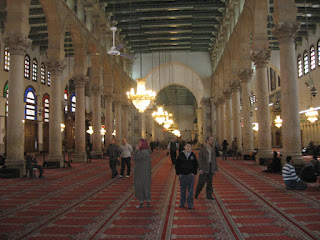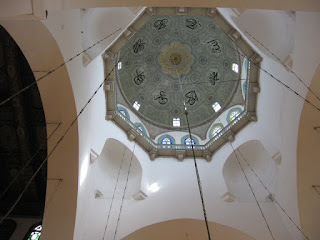The Temple of Jupiter in Damascus was built by the Romans, beginning during the rule of Augustus and completed during the rule of Constantius II.
Damascus was the capital of the Aramaean state Aram-Damascus during the Iron Age. The Arameans of western Syria followed the cult of Hadad-Ramman, the god of thunderstorms and rain, and erected a temple dedicated to him at the site of the present-day Umayyad Mosque.
The Temple of Hadad-Ramman continued to serve a central role in the city, and when the Romans conquered Damascus in 64 BCE they assimilated Hadad with their own god of thunder, Jupiter. Thus, they engaged in a project to reconfigure and expand the temple under the direction of Damascus-born architect Apollodorus, who created and executed the new design. The symmetry and dimensions of the new Greco-Roman Temple of Jupiter impressed the local population.
During the Persecution of pagans in the late Roman Empire, Theodosius I converted the temple to a church dedicated to John the Baptist. After the Muslims took over Damascus in 635 CE, the church was shared for seventy years, but Al-Walid I converted it to the Umayyad Mosque.
Source: Temple of Jupiter, Damascus - Wikipedia
Damascus was the capital of the Aramaean state Aram-Damascus during the Iron Age. The Arameans of western Syria followed the cult of Hadad-Ramman, the god of thunderstorms and rain, and erected a temple dedicated to him at the site of the present-day Umayyad Mosque.
The Temple of Hadad-Ramman continued to serve a central role in the city, and when the Romans conquered Damascus in 64 BCE they assimilated Hadad with their own god of thunder, Jupiter. Thus, they engaged in a project to reconfigure and expand the temple under the direction of Damascus-born architect Apollodorus, who created and executed the new design. The symmetry and dimensions of the new Greco-Roman Temple of Jupiter impressed the local population.
During the Persecution of pagans in the late Roman Empire, Theodosius I converted the temple to a church dedicated to John the Baptist. After the Muslims took over Damascus in 635 CE, the church was shared for seventy years, but Al-Walid I converted it to the Umayyad Mosque.
Source: Temple of Jupiter, Damascus - Wikipedia




























































